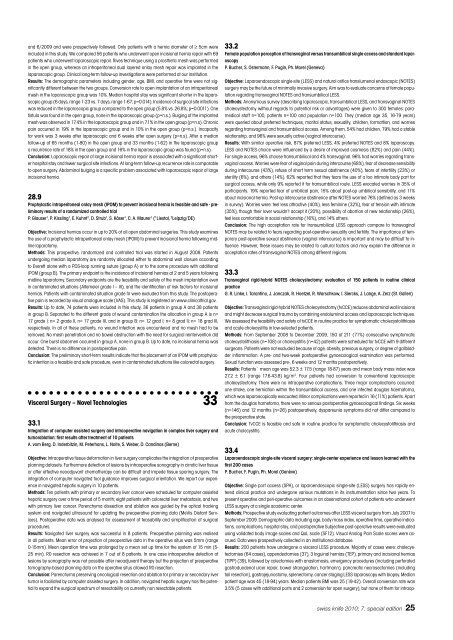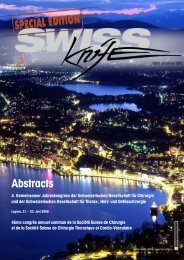Anorectal Manometry in 3D NEW! - Swiss-knife.org
Anorectal Manometry in 3D NEW! - Swiss-knife.org
Anorectal Manometry in 3D NEW! - Swiss-knife.org
You also want an ePaper? Increase the reach of your titles
YUMPU automatically turns print PDFs into web optimized ePapers that Google loves.
and 6/2009 and were prospectively followed. Only patients with a hernia diameter of ≥ 5cm were<br />
<strong>in</strong>cluded <strong>in</strong> this study. We compared 56 patients who underwent open <strong>in</strong>cisional hernia repair with 69<br />
patients who underwent laparoscopic repair. Rives technique us<strong>in</strong>g a prosthetic mesh was performed<br />
<strong>in</strong> the open group, whereas an <strong>in</strong>traperitoneal dual layered onlay mesh repair was implanted <strong>in</strong> the<br />
laparoscopic group. Cl<strong>in</strong>ical long-term follow-up <strong>in</strong>vestigations were performed at our <strong>in</strong>stitution.<br />
Results: The demographic parameters <strong>in</strong>clud<strong>in</strong>g gender, age, BMI, and operative time were not significantly<br />
different between the two groups. Conversion rate to open implantation of an <strong>in</strong>traperitoneal<br />
mesh <strong>in</strong> the laparoscopic group was 10%. Median hospital stay was significant shorter <strong>in</strong> the laparoscopic<br />
group (6 days, range 1-23 vs. 7 days, range 1-67; p=0.014). Incidence of surgical site <strong>in</strong>fections<br />
was reduced <strong>in</strong> the laparoscopic group compared to the open group (5.8% vs. 26.8%; p=0.0011). One<br />
fistula was found <strong>in</strong> the open group, none <strong>in</strong> the laparoscopic group (p=n.s.). Bulg<strong>in</strong>g of the implanted<br />
mesh was observed <strong>in</strong> 17.4% <strong>in</strong> the laparoscopic group and <strong>in</strong> 7.1% <strong>in</strong> the open group (p=n.s). Chronic<br />
pa<strong>in</strong> occurred <strong>in</strong> 19% <strong>in</strong> the laparoscopic group and <strong>in</strong> 10% <strong>in</strong> the open group (p=n.s.). Incapacity<br />
for work was 3 weeks after laparoscopic and 6 weeks after open surgery (p=n.s). After a median<br />
follow-up of 65 months (1-80) <strong>in</strong> the open group and 33 months (1-62) <strong>in</strong> the laparoscopic group<br />
a recurrence rate of 18% <strong>in</strong> the open group and 16% <strong>in</strong> the laparoscopic group was found (p=n.s).<br />
Conclusion: Laparoscopic repair of large <strong>in</strong>cisional hernia repair is associated with a significant shorter<br />
hospital stay and fewer surgical site <strong>in</strong>fections. At long-term follow-up recurrence rate is comparable<br />
to open surgery. Abdom<strong>in</strong>al bulg<strong>in</strong>g is a specific problem associated with laparoscopic repair of large<br />
<strong>in</strong>cisional hernia.<br />
28.9<br />
Prophylactic <strong>in</strong>traperitoneal onlay mesh (IPOM) to prevent <strong>in</strong>cisional hernia is feasible and safe - prelim<strong>in</strong>ary<br />
results of a randomized controlled trial<br />
P. Glauser 1 , P. Kissl<strong>in</strong>g 1 , E. Kuhnt 2 , D. Strub 1 , S. Käser 1 , C. A. Maurer 1 ( 1 Liestal, 2 Leipzig/DE)<br />
Objective: Incisional hernias occur <strong>in</strong> up to 20% of all open abdom<strong>in</strong>al surgeries. This study exam<strong>in</strong>es<br />
the use of a prophylactic <strong>in</strong>traperitoneal onlay mesh (IPOM) to prevent <strong>in</strong>cisional hernia follow<strong>in</strong>g midl<strong>in</strong>e<br />
laparotomy.<br />
Methods: This prospective, randomized and controlled trial was started <strong>in</strong> August 2008. Patients<br />
undergo<strong>in</strong>g median laparotomy are randomly allocated either to abdom<strong>in</strong>al wall closure accord<strong>in</strong>g<br />
to Everett alone with a PDS-loop runn<strong>in</strong>g suture (group A) or to the same procedure with additional<br />
IPOM (group B). The primary endpo<strong>in</strong>t is the <strong>in</strong>cidence of <strong>in</strong>cisional hernias at 2 and 5 years follow<strong>in</strong>g<br />
midl<strong>in</strong>e laparotomy. Secondary endpo<strong>in</strong>ts are the feasibility and safety of the mesh implantation even<br />
<strong>in</strong> contam<strong>in</strong>ated situations (Altemeier grade I – III), and the identification of risk factors for <strong>in</strong>cisional<br />
hernias. Patients with contam<strong>in</strong>ated situation grade IV were excluded from this study. The postoperative<br />
pa<strong>in</strong> is recorded by visual analogue scale (VAS). This study is registered on www.cl<strong>in</strong>icaltrial.gov.<br />
Results: Up to date, 74 patients were <strong>in</strong>cluded <strong>in</strong> this study, 36 patients <strong>in</strong> group A and 38 patients<br />
<strong>in</strong> group B. Separated to the different grade of wound contam<strong>in</strong>ation the allocation <strong>in</strong> group A is n=<br />
17 grade I; n= 2 grade II, n= 17 grade III, and <strong>in</strong> group B: n= 12 grad I; n= 8 grad II; n= 18 grad III,<br />
respectively. In all of these patients, no wound <strong>in</strong>fection was encountered and no mesh had to be<br />
removed. No mesh penetration and no bowel obstruction with the need for surgical re<strong>in</strong>tervention did<br />
occur. One burst abdomen occurred <strong>in</strong> group A, none <strong>in</strong> group B. Up to date, no <strong>in</strong>cisional hernia was<br />
detected. There is no difference <strong>in</strong> postoperative pa<strong>in</strong>.<br />
Conclusion: The prelim<strong>in</strong>ary short-term results <strong>in</strong>dicate that the placement of an IPOM with prophylactic<br />
<strong>in</strong>tention is a feasible and safe procedure, even <strong>in</strong> contam<strong>in</strong>ated situations like colorectal surgery.<br />
Visceral Surgery – Novel Technologies 33<br />
33.1<br />
Integration of computer assisted surgery and <strong>in</strong>traoperative navigation <strong>in</strong> complex liver surgery and<br />
tumorablation: first results after treatment of 10 patients<br />
A. vom Berg, D. Inderbitz<strong>in</strong>, M. Peterhans, L. Nolte, S. Weber, D. Cand<strong>in</strong>as (Berne)<br />
Objective: Intraoperative tissue deformation <strong>in</strong> liver surgery complicates the <strong>in</strong>tegration of preoperative<br />
plann<strong>in</strong>g datasets. Furthermore detection of lesions by <strong>in</strong>traoperative sonography <strong>in</strong> cirrotic liver tissue<br />
or after effective neoadjuvant chemotherapy can be difficult and impede tissue spar<strong>in</strong>g surgery. The<br />
<strong>in</strong>tegration of computer navigated tool guidance improves surgical orientation. We report our experience<br />
<strong>in</strong> navigated hepatic surgery <strong>in</strong> 10 patients.<br />
Methods: Ten patients with primary or secondary liver cancer were scheduled for computer assisted<br />
hepatic surgery over a time period of 5 month; eight patients with colorectal liver metastasis, and two<br />
with primary liver cancer. Parenchyma dissection and ablation was guided by the optical track<strong>in</strong>g<br />
system and navigated ultrasound for updat<strong>in</strong>g the preoperative plann<strong>in</strong>g data (MeVis Distant Services).<br />
Postoperative data was analysed for assessment of feasability and simplification of surgical<br />
procedures.<br />
Results: Navigated liver surgery was successful <strong>in</strong> 8 patients. Preoperative plann<strong>in</strong>g was realised<br />
<strong>in</strong> all patients. Mean error of projection of preoperative data <strong>in</strong> the operative situs was 5mm (range<br />
0-15mm). Mean operation time was prolonged by a mean set up time for the system of 15 m<strong>in</strong> (5-<br />
25 m<strong>in</strong>). R0 resection was achieved <strong>in</strong> 7 out of 8 patients. In one case <strong>in</strong>traoperative detection of<br />
lesions by sonography was not possible after neoadjuvant therapy but the projection of preoperative<br />
tomography-based plann<strong>in</strong>g data on the operative situs allowed R0 resection.<br />
Conclusion: Parenchyma preserv<strong>in</strong>g oncological resection and ablation for primary or secondary liver<br />
tumor is faciliated by computer assisted surgery. In addition, navigated hepatic surgery has the potential<br />
to expand the surgical spectrum of resectability on currently non resectable patients.<br />
33.2<br />
Female population perception of transvag<strong>in</strong>al versus transumbilical s<strong>in</strong>gle access and standard laparoscopy<br />
P. Bucher, S. Ostermann, F. Pug<strong>in</strong>, Ph. Morel (Geneva)<br />
Objective: Laparoendoscopic s<strong>in</strong>gle-site (LESS) and natural orifice translumenal endoscopic (NOTES)<br />
surgery may be the future of m<strong>in</strong>imally <strong>in</strong>vasive surgery. Aim was to evaluate concerns of female population<br />
regard<strong>in</strong>g transvag<strong>in</strong>al NOTES and transumbilical LESS.<br />
Methods: Anonymous survey (describ<strong>in</strong>g laparoscopic, transumbilical LESS, and transvag<strong>in</strong>al NOTES<br />
cholecystectomy without regards to potential risk or advantages) were given to 300 females: paramedical<br />
staff n=100, patients n=100 and population n=100. They (median age 35, 16-79 years)<br />
were queried about preferred techniques, marital status, sexuality, children, formattion, and worries<br />
regard<strong>in</strong>g transvag<strong>in</strong>al and transumbilical access. Among them, 54% had children, 79% had a stable<br />
relationship, and 96% were sexually active (vag<strong>in</strong>al <strong>in</strong>tercourse).<br />
Results: With similar operative risk, 87% preferred LESS, 4% preferred NOTES and 8% laparoscopy.<br />
LESS and NOTES choice were <strong>in</strong>fluenced by a desire of improved cosmesis (82%) and pa<strong>in</strong> (44%).<br />
For s<strong>in</strong>gle access, 96% choose transumbilical and 4% transvag<strong>in</strong>al. 96% had worries regard<strong>in</strong>g transvag<strong>in</strong>al<br />
access. Worries were fear of vag<strong>in</strong>al pa<strong>in</strong> dur<strong>in</strong>g <strong>in</strong>tercourse (68%), fear of decrease sensibility<br />
dur<strong>in</strong>g <strong>in</strong>tercourse (43%), refuse of short term sexual abst<strong>in</strong>ence (40%), fears of <strong>in</strong>fertility (23%) or<br />
sterility (6%), and others (14%). 62% reported that they fears the use of a too <strong>in</strong>timate body part for<br />
surgical access, while only 9% reported it for transumbilical route. LESS evocated worries <strong>in</strong> 35% of<br />
participants. 19% reported fear of umbilical pa<strong>in</strong>, 15% about post-op umbilical sensibility, and 11%<br />
about <strong>in</strong>cisional hernia. Post-op <strong>in</strong>tercourse abst<strong>in</strong>ence after NOTES worried 76% (def<strong>in</strong>ed as 3 weeks<br />
<strong>in</strong> survey). Worries were: feel less attractive (40%), less fem<strong>in</strong><strong>in</strong>e (32%), fear of tension with <strong>in</strong>timate<br />
(35%), though their lover wouldn’t accept it (20%), possibility of abortion of new relationship (26%),<br />
feel less comfortable <strong>in</strong> social relationship (16%), and 14% others.<br />
Conclusion: The high acceptation rate for transumbilical LESS approach compare to transvag<strong>in</strong>al<br />
NOTES may be related to fears regard<strong>in</strong>g post-operative sexuality and fertility. The importance of temporary<br />
post-operative sexual abst<strong>in</strong>ence (vag<strong>in</strong>al <strong>in</strong>tercourse) is important and may be difficult to <strong>in</strong>fluence.<br />
However, these issues may be related to cultural factors and may expla<strong>in</strong> the difference <strong>in</strong><br />
acceptation rates of transvag<strong>in</strong>al NOTES among different regions.<br />
33.3<br />
Transvag<strong>in</strong>al rigid-hybrid NOTES cholecystectomy: evaluation of 150 patients <strong>in</strong> rout<strong>in</strong>e cl<strong>in</strong>ical<br />
practice<br />
G. R. L<strong>in</strong>ke, I. Tarant<strong>in</strong>o, J. Janczak, R. Hoetzel, R. Warschkow, I. Siercks, J. Lange, A. Zerz (St. Gallen)<br />
Objective: Transvag<strong>in</strong>al rigid-hybrid NOTES cholecystectomy (tvCCE) reduces abdom<strong>in</strong>al wall <strong>in</strong>cisions<br />
and might decrease surgical trauma by comb<strong>in</strong><strong>in</strong>g endolum<strong>in</strong>al access and laparoscopic techniques.<br />
We assessed the feasibility and safety of tvCCE <strong>in</strong> rout<strong>in</strong>e practice for symptomatic cholecystolithiasis<br />
and acute cholecystitis <strong>in</strong> low-selected patients.<br />
Methods: From September 2008 to December 2009, 150 of 211 (71%) consecutive symptomatic<br />
cholecystolithiasis (n=108) or cholecystitis (n=42) patients were scheduled for tvCCE with 9 different<br />
surgeons. Patients were not excluded because of age, obesity, previous surgery, or degree of gallbladder<br />
<strong>in</strong>flammation. A pre- and two-week postoperative gynaecological exam<strong>in</strong>ation was performed.<br />
Sexual function was assessed pre-, 6 weeks and 12 months postoperatively.<br />
Results: Patients` mean age was 52.3 ± 17.5 (range 18-87) years and mean body mass <strong>in</strong>dex was<br />
27.2 ± 6.1 (range 17.6-43.8) kg/m 2 . Four patients had conversion to conventional laparoscopic<br />
cholecystectomy. There were no <strong>in</strong>traoperative complications. Three major complications occurred:<br />
one stroke, one herniation with<strong>in</strong> the transumbilical access, and one <strong>in</strong>fected douglas haematoma,<br />
which was laparoscopically evacuated. M<strong>in</strong>or complications were reported <strong>in</strong> 16 (11%) patients. Apart<br />
from the douglas hametoma, there were no serious postoperative gynaecological f<strong>in</strong>d<strong>in</strong>gs. Six weeks<br />
(n=146) and 12 months (n=26) postoperatively, dyspareunia symptoms did not differ compared to<br />
the preoperative state.<br />
Conclusion: TvCCE is feasible and safe <strong>in</strong> rout<strong>in</strong>e practice for symptomatic cholecystolithiasis and<br />
acute cholecystitis.<br />
33.4<br />
Laparoendoscopic s<strong>in</strong>gle-site visceral surgery: s<strong>in</strong>gle-center experience and lesson learned with the<br />
first 200 cases<br />
P. Bucher, F. Pug<strong>in</strong>, Ph. Morel (Genève)<br />
Objective: S<strong>in</strong>gle port access (SPA), or laparoendoscopic s<strong>in</strong>gle-site (LESS) surgery has rapidly entered<br />
cl<strong>in</strong>ical practice and undergone various mutations <strong>in</strong> its <strong>in</strong>strumentation s<strong>in</strong>ce two years. To<br />
present operative and peri-operative outcomes <strong>in</strong> an observational cohort of patients who underwent<br />
LESS surgery at a s<strong>in</strong>gle academic center.<br />
Methods: Prospective study evaluat<strong>in</strong>g patient outcomes after LESS visceral surgery from July 2007 to<br />
September 2009. Demographic data <strong>in</strong>clud<strong>in</strong>g age, body mass <strong>in</strong>dex, operative time, operative <strong>in</strong>dications,<br />
complications, hospital stay, and postoperative Subjective post-operative results were evaluated<br />
us<strong>in</strong>g validated body image scales and QoL scale (SF12). Visual Analog Pa<strong>in</strong> Scale scores were accrued.<br />
Data were prospectively collected <strong>in</strong> an <strong>in</strong>stitutional database.<br />
Results: 200 patients have undergone a visceral LESS procedure. Majority of cases were: cholecystectomies<br />
(64 cases), appendectomies (37), 3 Ingu<strong>in</strong>al hernias (TEP), primary and <strong>in</strong>cisional hernias<br />
(TIPP) (39), followed by colectomies with anastomosis, emergency procedures (<strong>in</strong>clud<strong>in</strong>g perforated<br />
gastroduodenal ulcer repair, bowel strangulation, hartmann), pancreatic necrosectomies (<strong>in</strong>clud<strong>in</strong>g<br />
tail resection), gastrojejunostomy, splenectomy, cancer stag<strong>in</strong>g LESS laparoscopy with biopsy. Median<br />
patient age was 45 (18-94) years. Median patients BMI was 25 (19-42). Overall conversion rate was<br />
3.5% (5 cases with additional ports and 2 conversion for open surgery), but none of them for <strong>in</strong>traop-<br />
swiss <strong>knife</strong> 2010; 7: special edition 25
















